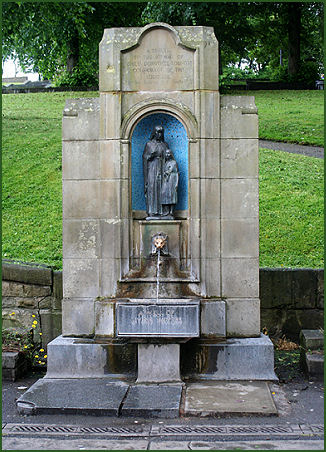St Ann's Well, Buxton
OS Grid Ref:- SK057735
 Visitors to the spa town of Buxton can still fill their own bottles from the permanent flow of mineral water at St Anne's Well in front of the Crescent.
Visitors to the spa town of Buxton can still fill their own bottles from the permanent flow of mineral water at St Anne's Well in front of the Crescent.
When the Romans arrived in Buxton a sacred site was attached to the main thermal spring, which they named Aquae Arnemetiae, which translates as ‘The Waters of The Goddess of the Grove'. The Romans built a bath at the thermal spring site. It is now under the west wing of The Crescent, and was described as ‘a leaden cistern' when The Crescent was built. An excavation of the main spring in 1974/5 uncovered a votive offering of many Roman coins.
The well has been a shrine to St. Anne since medieval times, prior to the Reformation it had been a pilgrim shrine, perhaps the best known in Derbyshire. A chapel then stood at the Holy Well, where pilgrims could pray and offer thanks, so many people believed themselves cured that the shrine was hung with cast-off crutches and sticks. This chapel was disolved on the orders of King Henry VIII in 1538. The shrine was locked and its idol, probably a statue of St Anne - was destroyed.
Mary Queen of Scots, who suffered badly from rheumatism and was being held in captivity by the Earl of Shrewsbury and his wife Bess of Hardwick at nearby Chatsworth, on the orders of her cousin, Elizabeth I, was amongst many famous visitors who came to 'take the waters' at Buxton in search of cures. Robert, Earl of Leicester and Lord Burghley were other Elizabethan visitors to the well.
William Cavendish, 5th Duke of Devonshire moved the public well to its present position in 1780 when he built the Crescent opposite to the site. The well that can be seen today is a Grade II listed building and carries the inscription 'A well of living waters', it dates to around 1940.
Each summer the wells are decorated according to the local tradition of well dressing. The Custom of Well Dressing is mostly unique to Derbyshire, its origins and history are not certain but its roots are said to come from pagan customs of making offerings to Water Gods. The well dressing weekend has now developed to become something of a town carnival.
